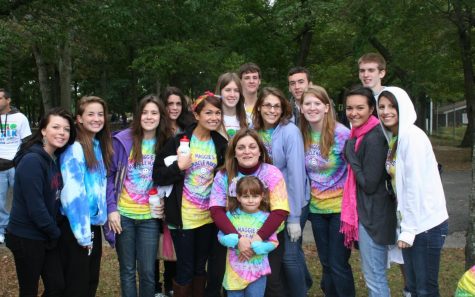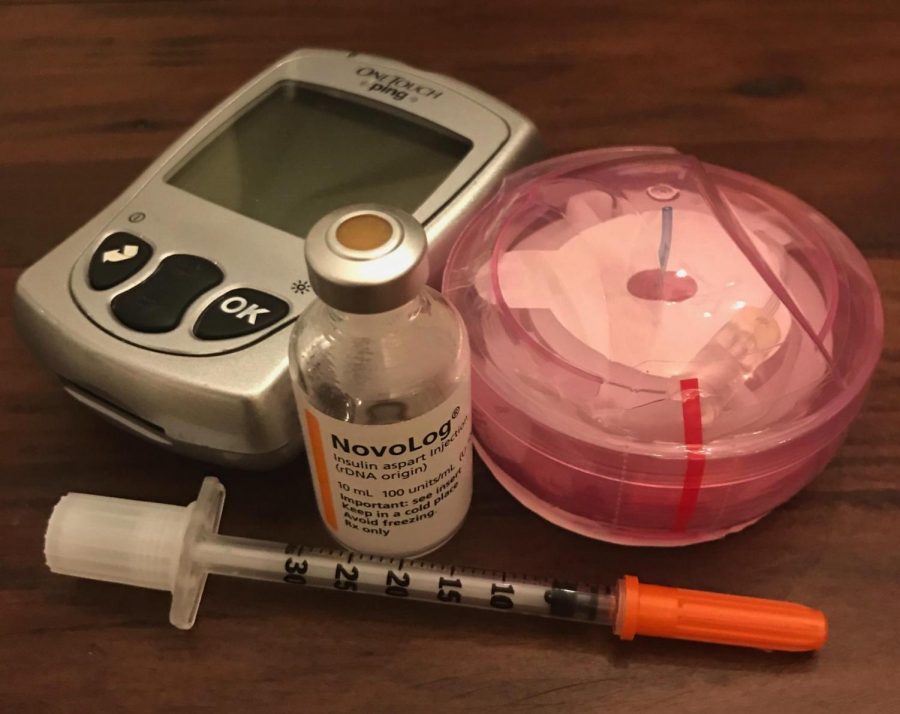The Beta-Stage of Diabetes Research
Exploring the advances for type 1 diabetes during November – diabetes recognition month.
More in Sports & Fitness
Photo by Maggie Sullivan
The diabetes supplies pictured are used daily.
Day-in and day-out we all tend to stick to our same routine: wake up, eat breakfast, go to school or work, and go home. It is so simple yet so automatic to us all. Sometimes, however, when you stop to realize how lucky we are to follow such a routine pattern you begin to look at it from a different lens. What if the pattern now consisted of wake up, check your blood, inject yourself with insulin, eat, check your blood again, and continue this throughout the day. For over three-million Americans, mostly children, this is the reality they face. Living with Type-1 Diabetes, nothing comes easy- yet, that doesn’t mean it has to become impossible.
For many of us, we have heard of diabetes before, but do we know the exact difference? For Type-1, it is when your pancreas cannot create any insulin needed for your body; for Type-2, your body does create insulin, it just doesn’t utilize it properly. So now that you know the difference what exactly does it entail? Well, insulin is a vital hormone to our body that moves glucose in the bloodstream and into our cells to be broken down into adenosine triphosphate (ATP) to allow us to function. As you can imagine, the inability to do this is not an issue that can be taken lightly, and must be dealt with in the most timely of manners. Before you start worrying I would not fret, Type-1 Diabetes is diagnosed usually in childhood, and is very seldom to be found entering into early adulthood and onwards. For most people with diabetes- around 90 to 95%- are dealing with Type-2 and not Type-1; while both are serious, the former is much more manageable than the latter.

Knowing about diabetes, that is only half the battle: while we can all sit and sympathize all we want, unless we have the disease we truly cannot fully grasp its consequences. The best we can do is hear from others who have to live with this everyday and find out from them what we cannot experience. For me, I was able to get in touch with Maggie Sullivan, a 12 year old girl, who has been diagnosed since the age of 4. Learning from her, you begin to see that part of the battle is all about your mentality; as with anything in life, you have to take what you are given and learn to adapt. As previously mentioned, it is all about precaution. For Maggie, she stated that “it doesn’t take up your whole life and you can still do everything you like.” However, as she pronounced “if diabetics don’t take care of themselves first you will be hospitalized as a kind of warning but if you don’t improve you will most likely die.” Thus, diabetes doesn’t mean that you have to alter your entire life, just that you have to take steps to protect yourself from what you have been given.
People fighting diabetes do not have to go at it alone: the JDRF is the world’s most renowned charity in raising funds for research into Type-1 diabetes. In addition, every fall the organization holds a walk to help raise awareness and funds to donate directly to the research that is ongoing to combat the currently incurable disease. Founded in 1970, the charity’s foremost goal is to create a world where Type-1 diabetes no longer exists; for those that do have it, it would easily be able to be cured. While the JDRF helps raise awareness and capital, what research in the now is helping to achieve this ambitious goal? Well, over the past decade the Harvard Stem Cell Institute and MIT’s Integrative Cancer Research Center have been working in tandem to find the cure they have been looking for. Now, in the year 2017, this goal seems to be right in our grasp.
It doesn’t take up your whole life and you can still do everything you like.
— Maggie, age 12
The key to understanding the research is to first understand how insulin is made: once more, in the pancreas are specialized cells called beta cells, these create the hormone that Type-1 diabetics lack. Back to the research, the key that has been used is a device that when implanted in mice was able to shield beta cells from immune system attacks. With this discovery made, the idea is that after the technology is perfected, the device can be transferred into Type-1 diabetes patients to give them working beta cells that will be protected and allow their bodies to create the insulin needed. While this is in an experimental stage with much more tweaking and testing to be done, it does promise the answer to the profound question that doctors and scientists have been looking for.
How far medical science has come in the world is staggering: from people dying of the common cold a mere two centuries ago, to now being able to shield cells and transplant the basic units that make life, mankind has come so far. For those with Type-1, you are not alone- and while life may not be ideal, hope of a cure is far more than a fantasy. If you are interested in helping to raise awareness or get involved, please contact the JDRF to see what more you can do to help make a difference in your local community. We have come this far- let us not stop now.
Photo by Michele Sullivan
Former PMHS Honor Society students at JDRF annual walk

Grade 12
“Always dream and shoot higher than you know you can do. Don’t
bother just to be better than your contemporaries or predecessors. Try
to...









